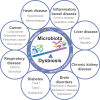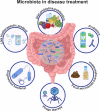Microbiota in health and diseases
- PMID: 35461318
- PMCID: PMC9034083
- DOI: 10.1038/s41392-022-00974-4
Microbiota in health and diseases
Abstract
The role of microbiota in health and diseases is being highlighted by numerous studies since its discovery. Depending on the localized regions, microbiota can be classified into gut, oral, respiratory, and skin microbiota. The microbial communities are in symbiosis with the host, contributing to homeostasis and regulating immune function. However, microbiota dysbiosis can lead to dysregulation of bodily functions and diseases including cardiovascular diseases (CVDs), cancers, respiratory diseases, etc. In this review, we discuss the current knowledge of how microbiota links to host health or pathogenesis. We first summarize the research of microbiota in healthy conditions, including the gut-brain axis, colonization resistance and immune modulation. Then, we highlight the pathogenesis of microbiota dysbiosis in disease development and progression, primarily associated with dysregulation of community composition, modulation of host immune response, and induction of chronic inflammation. Finally, we introduce the clinical approaches that utilize microbiota for disease treatment, such as microbiota modulation and fecal microbial transplantation.
© 2022. The Author(s).
Conflict of interest statement
The authors declare no competing interests.
Figures






References
Publication types
MeSH terms
LinkOut - more resources
Full Text Sources
Other Literature Sources
Medical

